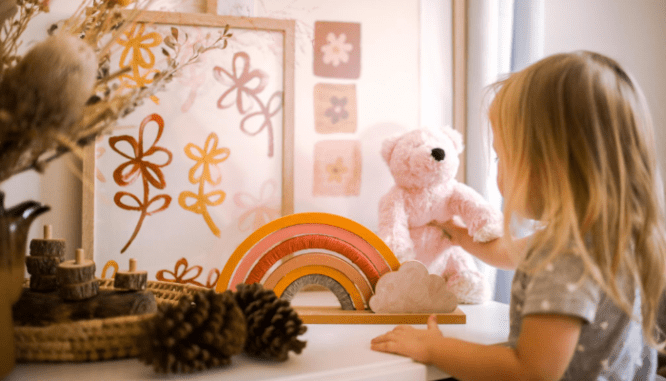Settling Kids into a New House: 14 Tips to Ease Your Transition
- Published on
- 4 min read
-
 Melissa Holtje Contributing AuthorClose
Melissa Holtje Contributing AuthorClose Melissa Holtje Contributing Author
Melissa Holtje Contributing AuthorMelissa enjoys using her experience as a house flipper, investment buyer, and waterfront home owner to help buyers and sellers thrive in the housing market. When not scouting real estate, you’ll most likely find her at the beach.
Even though everybody in the family (including the little ones) seemed excited to move when it was still just a possibility, now that you’re getting ready to settle into a new house, your children are acting less than enthused. Dragging feet, whining voices, pouting faces, and you with a household to transport. Yeah, you knew this was coming.
Moving to a new home requires extra amounts of flexibility and fortitude — from the entire family! And sometimes helping the littlest members of the household adjust to a new home is not as simple as filling out a change-of-address form.
To navigate the process of moving with kids, we consulted research and advice from psychologists and spoke with top real estate agents Rosie Rourke, who works with families in Washington, and Daryl Hanna, who specialties in single-family homes in Las Vegas. Their combined experience provides keen insight into helping kids move successfully and thrive in their new environment.

1. Acknowledge varied emotions
Moving to a new home is an emotional time for everyone involved. In fact, psychologists say that moving is one of the top five most emotionally stressful situations that one might experience during their lifetime.
That means, even if your moving situation holds elements of happiness for the kids — moving closer to grandparents or buying a house near the beach — they’re also bound to experience some sadness or even anger. That’s a natural response to stress.
In light of this fact, it’s best to allow kids the freedom and space to feel a variety of emotions. Instead of a continual pep talk, invite kids to express their feelings and examine the root of those feelings.
“Kids are resilient,” Rourke says. “Maybe more so than grown ups. Don’t hide the idea of moving. Bring them into the conversation and allow them to be a part of it.”
Offer validity by verbally acknowledging your own reflective emotions, such as, “I know how you feel. I’m really going to miss having Mrs. Smith next door, and it makes me sad.” These types of conversations can help kids know it’s safe to process emotions rather than bury them.
2. Read a book
As you’re preparing to move, you might want to read some books about moving with your kids.
Hearing stories of other kids going through similar situations can help normalize emotions and ease any fears. Here are a few recommended books about moving.
- Tigger’s Moving Day by Kathleen W. Zoehfeld and Robbin Cuddy (ages 2 to 4)
- A Kiss Goodbye by Audrey Penn (ages 3 to 7)
- The Berenstain Bears’ Moving Day by Stan and Jan Berenstain (ages 3 to 7)
- Teacup by Rebecca Young (ages 4 to 8)
- When You Are Brave by Pat Zietlow Miller (ages 4 to 8)
3. Work while they sleep
Seeing their things get sorted and packed up might be stressful for some kids, while other kids might find a sense of purpose in contributing to the work of moving.
Be aware of how the decluttering and packing process is affecting your child. If they seem rattled or anxious, you may want to consider packing while they are asleep. Also, you may want to dispose of items that cannot move with you — like that broken toy or the cracked sandbox in the backyard — while they’re sleeping to minimize their stress.
4. Pack a ‘favorites’ bag or box
When the time comes to pack up the final necessities, make sure all your child’s favorite items are consolidated into one special bag or box.
Favorite toys, stuffed animals, blankets, books, clothes, or pajamas can all be packed together for safekeeping. In order to keep those items close, your child may want to hold onto that bag in the car rather than putting it in the moving truck.

5. Help them find closure
In the final days before you move, be proactive and positive about the changes on the horizon.
Make a list of “lasts” — last trip to the park, last visit to the ice cream shop, last time feeding the neighborhood ducks — and check them off systematically. Bid farewell to friendly neighbors. And take time to say goodbye to your house, possibly room-by-room.
6. Make moving day as peaceful as possible
Moving day is full of physical and emotional stress for everyone in the family.
If you can, send the kids to play with grandparents or friends for the day. Knowing they’re safely out of the way while you’re lifting heavy furniture — and not exploring spaces that have yet to be child-proofed — will give you peace of mind on moving day.
Of course, getting someone to watch the kids is not always possible if you’re moving to a place where you don’t know anyone. In that case, maybe consider enlisting some extra help with the move itself. Hire movers, order a moving pod, or rent your moving truck for an extra day so moving day is not so stressful.
You could also plan some activities to keep the kids occupied and out of harm’s way. Have toddlers “label” boxes with washable markers. Give young kids a spray bottle and cloth for “cleaning duty.” Or have school-aged kids build a fort out of empty boxes.
7. Unpack kids’ rooms first
With the exception of setting up kitchen and bathroom basics, make kids’ rooms a top priority when unpacking in your new home.
Getting things settled in their new space will help kids feel more comfortable and stable. Also, let them help with the unpacking process so that they know where everything is located in their room.

8. Let them help with design choices
If you plan to make updates to your kids’ rooms, give them the freedom to help with decisions. Picking out wall paint, purchasing window treatments, and even choosing furniture placement can give kids a sense of ownership over their new space.
If you’ve got a child who has difficulty with unlimited decisions, Rourke recommends narrowing down the choices to three nice options. It might help to pull up some inspiration photographs, or older kids may enjoy creating their own Pinterest boards filled with room decor ideas. Personalizing their bedroom could make kids more excited about the move overall.
9. Get back into your routine
After you move, make every effort to get back on a normal schedule. Reestablishing a regular mealtime, snack time, naptime, and bedtime helps life feel more normal.
Don’t forget little traditions that your kids love, like lullabies, book time, or nightly strolls. Those daily activities are what make a house feel like home.
10. Unpack other rooms over time
Don’t feel like you have to unpack the entire house in a day. After the kids’ rooms are in order, the rest of the house can be unpacked slowly — perhaps once they get settled into their new school routine.
In the early days at your new home, focus on the kids and have some fun together in your new space. Memories need to be made. Boxes can wait!
11. Tour the neighborhood
If possible, make a list of fun things to do in your new neighborhood before moving.
Where’s the closest park, library, or sports field? Is there a fun cafe within walking distance? Can you bike to a nearby attraction?
You may also want to take a family walk or drive around your immediate neighborhood, especially during times when you see neighbors outside. Hanna says, “Take some time to drive around the neighborhood in the middle of the day on a weekend, and also on a weekday.”
Dog-walking, weed-pulling, or car-washing might present natural opportunities to introduce your family to neighbors. Research shows that knowing neighbors increases a sense of safety, which could be important for kids. (However, if there’s a pandemic, please remember to keep an appropriate distance from neighbors for health and safety reasons.)

12. Schedule neighbor playdates
Rourke suggests:
“Make brownies or bring flowers to your new neighbors to meet and see if other kids will be potential playmates.”
Kids may feel better about their new living situation if they find new friends their own age. As you meet other parents in the neighborhood or at school, try to set up playdates either in-person or virtually. You might be surprised by how excited your kids are to show off their brand new house!
13. Give it some time
Settling in doesn’t happen overnight. Your kids’ possessions may be physically in their room, but that doesn’t mean it truly feels like “their” room yet. Don’t be surprised by exclamations of “I just want to go home!” as you’re getting settled. Give kids time to continue to process complex emotions as they need to.
14. Set the tone
Above all, don’t forget that your kids are watching you. Oftentimes you as the parent or guardian are able to set the emotional tone for any given situation.
If you’re positive and relaxed throughout your move, kids are more likely to follow your cues and be positive and relaxed, too. And in a few years, you can all fondly reminisce about the time you moved into your new house.
Header Image Source: (Syda Productions / Shutterstock)
